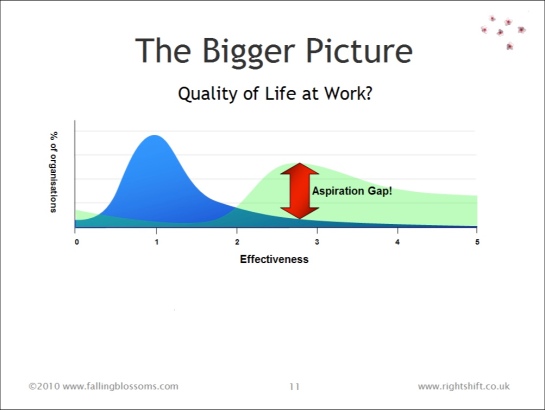The Aspiration Gap
The Aspiration Gap
Some years ago I wrote a post entitled “Delivering Software is Easy“. As a postscript I included a chart illustrating where all the jobs are in the software / tech industries, compared to the organisations (and jobs) that folks would like to work in. It’s probably overdue to add a little more explanations to that chart.
Here’s the chart, repeated from that earlier post for ease of reference:
The blue curve is the standard Rightshifting curve, explained in several of my posts over the years – for example “Rightshifting in a Nutshell“.
The green curve is the topic of this post.
The Green Curve
The green curve illustrates the distribution of jobs that e.g. developers, testers, coaches, managers, etc. would like to have. In other words, jobs that are most likely to best meet their needs (different folks have different needs, of course).
Down around the horizontal zero index position (way over to the left), some folks might like to work in these (Adhoc) organisations, for the freedom (and autonomy) they offer (some Adhoc organisations can be very laissez-faire). These jobs are no so desirable, though, for the raft of dysfunctions present in Adhoc organisations generally (lack of things like structure, discipline, focus, competence, and so on).
The green curve moves to a minimum around the 1.0 index position. Jobs here are the least desirable, coinciding as they do with the maximum number of Analytic organisations (median peak of the blue curve). Very few indeed are the folks that enjoy working for these kinds of organisations, with their extrinsic (imposed) discipline, Theory-X approach to staff relations and motivations, strict management hierarchies, disconnected silos, poor sense of purpose, institutionalised violence, and all the other trappings of the Analytic mindset. Note that this is where almost all the jobs are today, though. No wonder there’s a raging epidemic of disengagement across the vast swathe of such organisations.
The green curve then begins to rise from its minimum, to reach a maximum (peak) coinciding with jobs in those organisations having a “Mature Synergistic” mindset (circa horizontal index of 2.8 to 3). These are great places to work for most folks, although due to the very limited number of such organisations (and thus jobs), few people will ever get to experience the joys of autonomy, support for mastery, strong shared common purpose, intrinsic motivation, a predominantly Theory-Y approach to staff relations, minimal hierarchy, and so on.
Finally (past horizontal index 3.0) the green curve begins to fall again, mainly because working in Chaordic organisations can be disconcerting, scary (although in a good way), and is so far from most folks’ common work experiences and mental image of a “job” that despite the attractions, it’s definitely not everyone’s cup off tea.
Summary
The (vertical) gap at any point along the horizontal axis signifies the aspiration gap: the gap between the number of jobs available (blue curve) and the level of demand for those jobs (green curve) – i.e. the kind of jobs folks aspire to.
If you’re running an organisation, where would you need it to be (on the horizontal axis) to best attract the talent you want?
– Bob
Footnote
For explanations of Adhoc, Analytic, Synergistic and Chaordic mindsets, see e.g. the Marshall Model.


Pingback: Five Blogs – 24 April 2019 – 5blogs